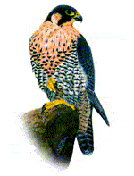| New Jersey Division of Fish and Wildlife |
Peregrine Project Gearing Up for Technology
Endangered peregrine falcons have called 101 Hudson Street in Jersey City home for several years. Residing high atop the tallest New Jersey building, the pair's every activity will soon be visible to all thanks to a grant from Verizon Foundation. Soon a webcam will be trained on the breeding pair, enabling anyone with Internet access to view their behavior and anticipated offspring. A display in the lobby of the building will provide building employees and visitors with a "live cam" view of the birds as well as background on peregrines in New Jersey.
Through a procedure known as "hacking", birds of prey like peregrines were brought back to New Jersey during the 1980s. Housed in high towers along coastal areas, peregrines were brought from Cornell University's Peregrine Fund for reintroduction to the Garden State by the Division of Fish & Wildlife's Endangered and Nongame Species Program. We now have 15 to 17 pairs in New Jersey. Nesting birds continue to receive monitoring, and young are banded annually by biologists. Volunteers check the progress of young in the nests from a distance. All nesting peregrines in New Jersey use man-made sites, like tall buildings and bridge spans.
The peregrines in Jersey City's 101 Hudson building were first spotted by L-Cor employee Bob Barth. He contacted the Division of Fish & Wildlife's Endangered and Nongame Species Program to get protection and help for the birds. Last year, a three-sided nest box was located on the roof of the building which the birds took to right away. Building employees were alerted to the birds' presence, and were very protective of their resident endangered species. Last year the pair produced 2 young.
Birds reside at 101 year-round. During March, they begin territorial displays in anticipation of the breeding season. Eggs will be laid in April, and are expected to hatch in mid-May. Young will fledge the nest in mid-summer. An average brood is 3 to 4 eggs.
Stay tuned to the Division of Fish and Wildlife's website for updates on the peregrine project (www.njfishandwildlife.com). Teachers who wish to learn more should attend the Peregrine Workshop on May 23. You can help by donating your state income tax refund through the Wildlife Check-off on your state income tax form.
By Mimi Dunne
Principal Biologist
 Peregrine falcons became endangered during the 1960s and 70s due to pesticide contamination. DDT was widely applied to control mosquitoes and other insects. It is a long-lived poison which bioaccumulates in the food web, and becomes concentrated enough in top predators to cause eggshell thinning and death. When DDT was banned, peregrines, osprey, bald eagles and other carnivores at the top of the food chain rebounded with a little help from wildlife management activities.
Peregrine falcons became endangered during the 1960s and 70s due to pesticide contamination. DDT was widely applied to control mosquitoes and other insects. It is a long-lived poison which bioaccumulates in the food web, and becomes concentrated enough in top predators to cause eggshell thinning and death. When DDT was banned, peregrines, osprey, bald eagles and other carnivores at the top of the food chain rebounded with a little help from wildlife management activities.